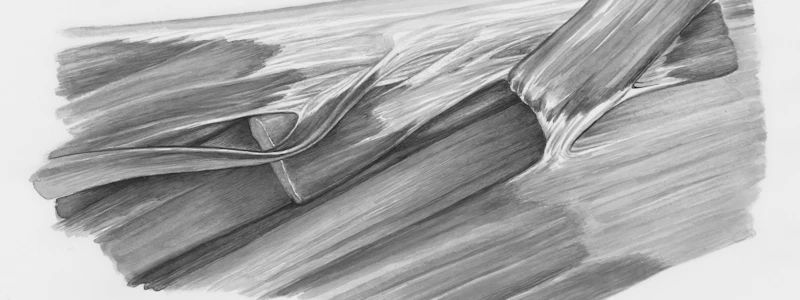Podcast
Questions and Answers
What is the role of the nervous system in muscle function?
What is the role of the nervous system in muscle function?
- It supplies energy directly to muscles.
- It controls muscles and how they function. (correct)
- It is responsible for muscle growth.
- It provides oxygen to the muscles.
Which type of muscle can you control voluntarily?
Which type of muscle can you control voluntarily?
- Smooth muscles
- Cardiac muscles
- Skeletal muscles (correct)
- Involuntary muscles
What happens to muscles when they undergo atrophy?
What happens to muscles when they undergo atrophy?
- They harden and become stronger.
- They increase in size.
- They expand as a result of exercise.
- They decrease in size and strength. (correct)
What is the significance of antagonist pairs in muscle movement?
What is the significance of antagonist pairs in muscle movement?
Which of the following describes the process of muscle flexibility?
Which of the following describes the process of muscle flexibility?
What is the term for moving body parts towards the body?
What is the term for moving body parts towards the body?
What percentage of body weight is composed of muscles?
What percentage of body weight is composed of muscles?
Which type of tissue connects muscle to bone?
Which type of tissue connects muscle to bone?
Flashcards
Number of muscles
Number of muscles
The human body has 638 muscles.
Largest muscle location
Largest muscle location
The largest muscle in the human body is located in the thigh.
Smallest muscle location
Smallest muscle location
The smallest muscle in the human body is found in the ear.
Muscle composition
Muscle composition
Signup and view all the flashcards
Voluntary muscles
Voluntary muscles
Signup and view all the flashcards
Involuntary muscles
Involuntary muscles
Signup and view all the flashcards
Hypertrophy
Hypertrophy
Signup and view all the flashcards
Flexion
Flexion
Signup and view all the flashcards
Study Notes
Muscles Study Guide
- The human body has 638 muscles.
- The largest muscle is in the thigh.
- The smallest muscle is in the ear.
- Muscles are made of protein.
- Muscles are controlled by the nervous system.
- Muscles make up more than 40-50% of body weight.
Voluntary Muscles
- Voluntary muscles are those you control.
Involuntary Muscles
- Involuntary muscles work automatically without conscious control.
Excitable/Irritable
- Muscles can respond to stimulation from nerves.
- Muscle response to stimulation can vary.
Flexible
- Muscles can return to their original shape and length after being stretched or contracted.
Abduction
- Moving parts away from the body.
Adduction
- Moving parts toward the body.
Extension
- Straightening the joint to increase the angle between parts.
Flexion
- Bending a joint to decrease the angle between parts.
Rotation
- Moving a body part around its axis.
Muscle Hypertrophy
- Muscle growth.
Muscle Atrophy
- Muscle wasting.
Antagonistic Muscles
- Muscles that work together in pairs.
- One muscle contracts while the other relaxes.
Tendons
- Connect muscles to bones.
Fascia
- Connects muscles to muscles.
Types of Muscles
- Cardiac muscle: Found in the heart; involuntary.
- Smooth muscle: Found in organs like the stomach and intestines; involuntary.
- Skeletal muscle: Attached to bones; voluntary.
Quiz Questions
- Question 1: What is the technical term for muscle growth?
- Answer: Hypertrophy
- Question 2: What is the technical term for muscle wasting?
- Answer: Atrophy
- Question 3: What is the term for limbs moving away from the body?
- Answer: Abduction
- Question 4: What is the term for a movement that decreases the angle between two bones or body parts?
- Answer: Flexion
- Question 5: What is the term for a movement that increases the angle between two bones or body parts?
- Answer: Extension
- Question 6: Which type of muscle is found in the digestive system?
- Answer: Smooth Muscles
- Question 7: Which type of muscle is found in the heart?
- Answer: Cardiac Muscle
- Question 8: Which is the only type of muscle that is voluntary?
- Answer: Skeletal Muscle
- Question 9: Which tissue connects muscle to muscle?
- Answer: Fascia
- Question 10: Which muscles are found in the thighs?
- Answer: Quadriceps and Hamstrings
Studying That Suits You
Use AI to generate personalized quizzes and flashcards to suit your learning preferences.




